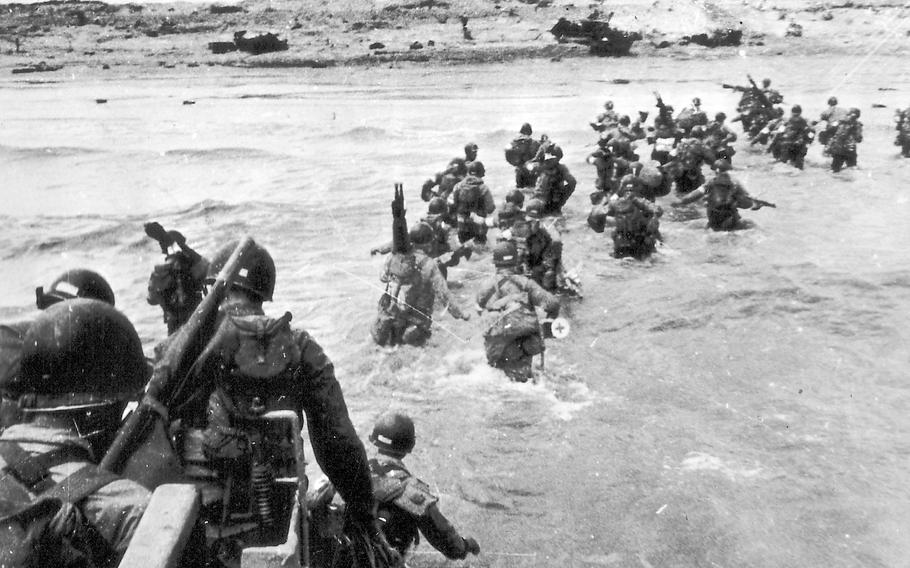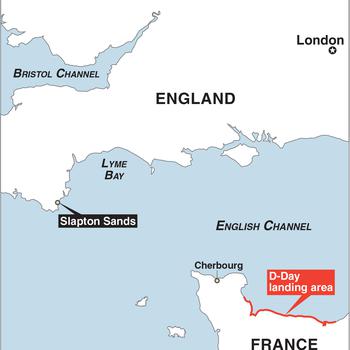
American soldiers land on Utah Beach in June 1944. (Conseil Régional de Basse-Normandie/National Archives USA)
A dress rehearsal for the D-Day assault on Utah Beach cost the 4th Infantry Division and associated units nearly four times as many lives as they lost in the landing itself five weeks later.
The training exercise from April 22-25, 1944, was codenamed Exercise Tiger and designed to prepare assault troops and combat engineers for the landing at Utah — as part of the Allied invasion of Normandy, France, that helped bring an end to Adolf Hitler’s “Thousand-Year Reich.”
However, the exercise in southwest England went off the rails due to poor communications and an unexpected attack by German “E boats,” small, maneuverable, fast-attack craft that sank or damaged four LSTs, or Landing Ship, Tanks, filled with soldiers and sailors.
At least 749 American service members were killed, according to the Naval History and Heritage Command. Many of them drowned after they jumped into the chilly waters without proper training on how to wear life preservers while wearing full field packs.

In preparation for the D-Day invasion of Normandy, France, the U.S. Army planned a series of exercises in April 1944 around Slapton Sands, a village in southwestern England along the English Channel. (Noga Ami-rav/Stars and Stripes)
By comparison, the 4th Infantry landed 21,000 soldiers at Utah Beach on June 6, 1944, with only 197 deaths. Overall, at least 4,414 Allied soldiers were killed on June 6, including an estimated 2,501 Americans, most during the landing at Omaha Beach.
In preparation for D-Day, the U.S. Army planned a series of exercises around Slapton Sands, a village in southwestern England along the English Channel. The area was chosen because the topography resembled the Normandy beaches.
The 30,000-strong civilian population was evacuated, and training began in mid-December 1943 with two major exercises planned for late April and early May.
The training for the Utah landing was set to begin April 22, climaxing with a beach landing five days later.
After assembling troops and equipment, the assault forces disembarked during the night of April 26, sailing through Lyme Bay proceeded by minesweepers as if they were crossing the Channel. The Royal Navy provided destroyers and gunboats for protection.
Things began to go wrong early on the morning of April 27 with a naval bombardment. Gen. Dwight D. Eisenhower, the supreme allied commander, believed it was important to use live ammunition so the soldiers, most of whom had never been in combat, could get used to the sounds and smells of battle.
Some of the vessels were delayed so Rear Adm. Don Moon, the exercise commander, postponed the landings by one hour. Some vessels did not receive the order and landed soldiers during the live-fire assault, producing an undetermined number of casualties.
Things got even worse before dawn on the following morning when six German E boats slipped into the area under cover of darkness and opened fire with cannons and torpedoes. Two LSTs packed with soldiers and sailors were sunk and two others were heavily damaged, according to after-action reports.
“The worst memory I have is setting off in the lifeboat away from the sinking ship and watching bodies float by,” one of the LST survivors, Dale Rodman, was quoted by the Daily Telegraph of London in April 1994.
To make matters worse, an investigation found British warships detected the German boats but the American vessels didn’t get the word because of communications problems.
“We were on the wrong [radio] frequency,” former Navy radioman Steve Sadlon said in an interview produced by Britain’s Gosh TV in 2013. “They knew that these E boats were approaching us and they never let us know that we were in danger.”
He said he jumped overboard but one signalman told him that he wasn’t going into such cold water.
“I said to him, ‘OK take your choice’,” Sadlon recounted. “So I pointed to the water and said, ‘You’re going to freeze to death,’ and I pointed to the fire and said, ‘You’re going to burn to death.’ He burned to death. He made his choice.”
The disaster in Lyme Bay sent shockwaves through the Allied command as it was preparing for the high-risk invasion of Western Europe. As a first step, radio frequencies used by the British and American navies were standardized.
Eisenhower ordered all efforts be made to find the bodies of 10 American officers who had firsthand knowledge of details of the upcoming Normandy invasion, including locations of German defenses to be destroyed.
In addition, the Americans insisted plans be changed to provide for heavy bombing of the French port of Cherbourg, where the German E boats were based.
Publicly, however, the command clamped down on any mention of what had happened at Slapton Sands. Troops who had taken part in the exercise were threatened with courts-martial if they breathed a word of the disaster.
The Allied Supreme Command didn’t release information on the catastrophe until a brief statement in August 1944. By that time, the story of Slapton Sands was subsumed by heavy fighting and higher death tolls in the Normandy fighting.
It was not until the early 1970s when salvagers discovered a submerged Sherman tank that word of the disaster began emerging. A monument to those who died was erected at Slapton Sands in 1984.